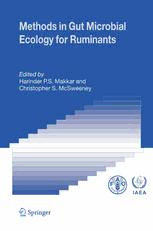
Methods in Gut Microbial Ecology for Ruminants PDF
Preview Methods in Gut Microbial Ecology for Ruminants
METHODSINGUTMICROBIALECOLOGYFORRUMINANTS Methods in Gut Microbial Ecology for Ruminants Editedby HARINDERP.S.MAKKAR AnimalProductionandHealthSection JJJointFAO/IAEADivisionofNuclearTechniquesinFoodandAgriculture InternationalAtomicEnergyAgency VVVienna,Austria CHRISTOPHERS.McSWEENEY CSIROLivestockIndustries QueenslandBiosciencePrecinct StLucia,Queensland,Australia AC.I.P.CataloguerecordforthisbookisavailablefromtheLibraryofCongress. ISBN-10 1-4020-3790-2(HB) ISBN-13 978-1-4020-3790-0(HB) ISBN-10 1-4020-3791-0(e-book) ISBN-13 978-1-4020-3791-7(e-book) PublishedbySpringer, P.O.Box17,3300AADordrecht,TheNetherlands www.springeronline.com Printedonacid-freepaper (cid:1)C 2005InternationalAtomicEnergyAgency Nopartofthisbookmaybereproduced,storedinaretrievalsystem,ortransmitted inanyformorbyanymeans,electronic,mechanical,photocopying,microfilming,recording, orotherwise,withoutwrittenpermissionfromthePublisher,withtheexception ofanymaterialsuppliedspecificallyforthepurposeofbeingentered andexecutedonacomputersystem,forexclusiveusebythepurchaserofthework. PrintedintheNetherlands. Contents Foreword vii Introduction ix EditorialNote xi Part1. Designingin-vivoMicrobialEcologyStudies 1.1. Experimentaldesignsforrumenmicrobiology 03 AdrianR.Egan Part2. ClassicalMethodsforIsolation,Enumeration,Cultivation andFunctionalAssaysofRumenMicrobes 2.1. Rumenbacteria 23 ChristopherS.McSweeney,StuartE.DenmanandRoderickI.Mackie 2.2. Bacteriophages 39 AtholV.Klieve 2.3. Methanogenicarchaea 47 KKKeithN.Joblin 2.4. Anaerobicfungi 55 MichaelK.Theodorou,JayneBrookmanandAnthonyP.J.Trinci 2.5. Ciliateprotozoa 67 BurkA.Dehority Part3. PCR-BasedMethodsforAnalysisofPopulations andGeneExpression 3.1. Nucleicacidextraction,oligonucleotideprobesandPCRmethods 81 ZhongtangYuandRobertJ.Forster 3.2. Quantitative(real-time)PCR 105 StuartE.DenmanandChristopherS.McSweeney vi Contents Part4. MolecularFingerprintingTechniquesforGenotypicAnalysisof PureCulturesandMicrobialCommunities 4.1. Denaturinggradientgelelectrophoresis 119 SvetlanaA.Kocherginskaya,IsaacK.O.CannandRoderickI.Mackie 4.2. Bacteriophagepopulations 129 AtholV.KlieveandRosalindA.Gilbert 4.3. Anaerobicfungalpopulations 139 JJJayneL.BrookmanandMatthewJ.Nicholson 4.4. RAPD,RFLP,T-RFLP,AFLP,RISA 151 StuartE.Denman,MakotoMitsumoriandChristopherS.McSweeney Part5. DNACloneLibrariesofMicrobialCommunities 5.1. 16S/18SribosomalDNAclonelibraryanalysisofrumenmicrobial diversity 163 André-DenisG.Wright,KiyoshiTajimaandRustamI.Aminov Part6. UseofSmallSubunitRibosomalRNADirectedOligonucleotide ProbesforMicrobialPopulationStudies 6.1. Northernblotanalysistoinvestigatetheabundanceofmicro-organisms 177 DenisO.Krause 6.2. Wholecellprobingwithfluorescentlylabelledprobesforinsitu analysisofmicrobialpopulations 191 LindaL.Blackall 6.3. Combinedfluorescenceinsituhybridizationandmicroautoradiography (FISH-MAR) 201 ManeeshaP.Ginige Part7. GenomicAnalysisofMicrobialEcosystems 7.1. Metagenomicanalysisofthemicrobiomesinruminants andotherherbivores 209 MarkMorrison,SarahE.Adams,KarenE.Nelsonand GraemeT.Attwood ChapterwiseKeywords 221 KeywordIndex 223 Foreword Asaresultofvarioushumanactivities,suchasincreaseinhumanpopulation,decrease inarablelandduetosoildegradation,urbanization,industrializationandassociated increaseinthedemandforlivestockproducts,dramaticchangesareoccurringinthe globalruminantlivestocksector.Thesechangesincludeshiftinthesizeofregional livestock populations and in the types of management and feeding systems under wwwhichruminantlivestockareheld,andincreaseddemandofawiderrangeofquality attributes from animal agriculture, not just of the products themselves but also of the methods used in their production. The livestock sector will need to respond to newchallengesofincreasinglivestockproductivitywhileprotectingenvironmentand humanhealthandconservingbiodiversityandnaturalresources. Themicro-organismsinthedigestivetractsofruminantlivestockhaveaprofound influenceontheconversionoffeedintoendproducts,whichcanimpactonthean- imal and the environment. As the livestock sector grows particularly in developing countries, there will be an increasing need to understand these processes for bet- ter management and use of both feed and other natural resources that underpin the developmentofsustainablefeedingsystems. Untilrecently,knowledgeofruminantgutmicrobiologywasprimarilyobtainedus- ingclassicalculture-basedtechniques,suchasisolation,enumerationandnutritional characterization, which probably only account for 10–20% of the rumen microbial population.Newgene-basedtechnologiescannowbeemployedtoexaminemicrobial diversitythroughtheuseofsmallsub-unitribosomalDNAanalysis(e.g.16SrDNA) andtounderstandthefunctionofcomplexmicrobialecosystemsintherumenthrough metagenomicanalysis.Thesetechnologieshavethepotentialtorevolutionizetheun- derstandingofrumenfunctionandwillovercomethelimitationsofclassical-based techniques, including isolation and taxonomic identification of strains important to efficientrumenfunctionandbetterunderstandingoftherolesofmicro-organismsin relationtoachievinghighproductivityanddecreasingenvironmentalpollutants. ThisbookhasbeenproducedbytheJointFAO/IAEADivisionofNuclearTech- niqueinFoodandAgriculture,IAEAVienna,AustriaincollaborationwiththeCSIRO Livestock Industries, Brisbane, Australia. It gives a comprehensive up-to-date ac- countofthemethodologiesandtheprotocolsforconventionalandmodernmolecular vii H.P.S.MakkarandC.S.McSweeney(eds.),MethodsinGutMicrobialEcologyforRuminants,vii. ©2005IAEA.PrintedintheNetherlands. viii Foreword techniques that are currently in use for studying the gut microbial ecology of ru- minants. Each chapter has been contributed by experts in the field. The techniques and procedures described are also relevant and adaptable to other gastrointestinal ecosystems and the microbiology of anaerobic environments in general. The fu- tureofruminantgutmicrobiologyresearchisdependentupontheadoptionofthese molecular-based research technologies, and the challenge at present is the use of thesetechnologiestoimproveruminantproductionanddecreaseenvironmentpollu- tantsthroughabetterunderstandingofmicrobialfunctionandecology.Itishopedthat thisbookwillequipthereadersbetterinordertomeetthisunprecedentedchallenge. JamesD.Dargie ShaunG.Coffey Director,JointFAO/IAEADivision Chief,CSIROLivestockIndustries ofNuclearTechniquesinFoodandAgriculture Brisbane,Australia VVVienna,Austria Introduction Currentapproachestotheevaluationofdigestibilityandthenutritivevalueoffeed resourcesusingconventionalinvitrofeedevaluationandanimalstudieshaveresulted in a large body of information about nutrient composition, digestion kinetics and digestibility. However, these techniques are unable to describe the microbial mech- anisms involved in digestion by ruminants and other herbivores, and are unlikely to result in the development of new feeding strategies. Conventional culture-based methods of enumerating and identifying rumen bacteria are being rapidly replaced bythedevelopmentofnucleicacid-basedtechniquesthatcanbeusedtocharacterise complex microbial communities. Ruminant nutritionists and microbiologists have recognized the importance of molecular microbial ecology, but many have found it difficulttoemploythemostappropriatetechniquesbecausetheyarenotfamiliarwith the methods. In addition, this field is developing very rapidly and even researchers withexperienceinmolecularmicrobialecologyfinditdifficulttokeepabreastwith theincreasingnumberoftechniquesandalternatives. This manual is written by an expert group of scientists interested in ruminant digestionandgutmicrobiology.Themostrecentandup-to-datemethodsinmolecular microbialecologywithspecialemphasisonruminantsarecollatedandinterpretedin thisbook.Themethodswillprovidethereadersaneasyaccesstomoleculartechniques thataremostrelevantandusefultotheirareaofinterest.Theauthorshaveattempted towriteinarecipe-likeformatdesignedfordirectpracticaluseinthelaboratoryand also to provide insight into the most appropriate techniques, their applications and the type of information that could be expected. These aspects have been supported byinclusionoftherelevantliterature. The contents of the manual are presented in a sequence that recognizes the key elementsinstudyinggutmicrobialecology.Thefirstchapterprovidesaperspective onhowtodesignanimaltrialsinwhichmicrobialecologyisstudied.Oftenthepower of the new molecular techniques is diminished by an inappropriate design in terms of animal number, sampling frequency, location and replication. The second chap- ter describes the classical culture-based methods for studying rumen microbes, as thesemethodsareoftenapre-requisitetoemployingmoleculartechniques.Chapters 3–6provideinformationonthebasicunderpinningtechniquesandtheprotocolsin ix H.P.S.MakkarandC.S.McSweeney(eds.),MethodsinGutMicrobialEcologyforRuminants,ix–x. ©2005IAEA.PrintedintheNetherlands. x Introduction molecular ecology, such as DNA extraction from environmental samples, the poly- merasechainreaction(PCR),oligonucleotideprobeandprimerdesignandDNAfin- gerprintingamongstothers.Theapplicationofthesetechniquestomicrobialdetection andidentificationarediscussed.Specializedtechniquessuchasdenaturinggradient gelelectrophoresis(DGGE)and16S/18SribosomalDNAlibrariesforstudyingcom- plex communities that contain unculturable organisms are also described. Many of thesetechniquesareusedtoidentifyandenumeratethepopulationoforganismsthat arepresentinasample.However,thefieldisrapidlymovingtoafunctionalanalysis ofthemicrobesinanecosystem,andsomeofthemethodsbeingemployedtomeasure genesexpressionaredescribedinChapter3.InChapter6,knowledgeaboutlocation and spatial relationships of micro-organisms in their natural environment that are oftenessentialforunderstandingthefunctionoftheseorganismsarediscussed.The final chapter deals with metagenomic technologies, which provide the potential to captureandstudytheentiremicrobiome(thepredominantgenomes)fromacomplex microbial community, such as the rumen. The rapid high-throughput technologies developed in mapping the human genome are now being deployed to study micro- bialecosystems.Anexplosionofknowledgeinthefieldofmicrobialecologyisnow expected. The editors wish to acknowledge the contributions made by all the authors who participated in the publication of this manual. They have spent considerable time gathering information from many sources into a focussed document that enables thereadertounderstandhowtechniqueshaveevolvedandthecontextinwhichthe methodsshouldbeappliedtoaddressspecificissuesrelatingtogutmicrobialecology. We believe that this manual will ‘demystify’ the methods in molecular microbial ecologyforreaders,whoarenoviceinthefieldbutareexcitedbytheprospectsofthe technology.Itwouldalsobeinvaluablefortheexperiencedworkersstrivingforgiving newdimensiontotheirresearch–expandingtheworkinotherfieldsandinitiating cross-cutting activities. This manual is seen as the first step towards understanding andmanipulatinggutmicro-organismsasitisexpectedthatthetechniquesandthe methodologiesassociatedwiththestudyofmolecularmicrobialecologywillcontinue togrowandevolve.Akeychallengeforthefuturewillbethesimplificationofthese techniques, so that these become tools of routine use in nutritional, environmental andecologicallaboratories. HarinderP.S.Makkar ChristopherS.McSweeney AnimalProductionandHealthSection CSIROLivestockIndustries JJJointFAO/IAEADivision QueenslandBiosciencePrecinct InternationalAtomicEnergyAgency StLucia,Queensland,Australia VVVienna,Austria Editorial Note The use of particular designations of countries or territories does not imply any judgementbythepublisher,andtheIAEA,astothelegalstatusofsuchcountriesor territories,oftheirauthoritiesandinstitutionsorofthedelimitationoftheirbound- aries. Thementionofnamesofspecificcompaniesorproducts(whetherornotindicated asregistered)doesnotimplyanyintentiontoinfringeproprietaryrights,norshould itbeconstruedasanendorsementorrecommendationonthepartoftheIAEA. Allpatents,registeredtrademarksandownershipforproducts,reagentsandpro- cessesmentionedinthispublicationshouldberespected. xi H.P.S.MakkarandC.S.McSweeney(eds.),MethodsinGutMicrobialEcologyforRuminants,xi. ©2005IAEA.PrintedintheNetherlands.
